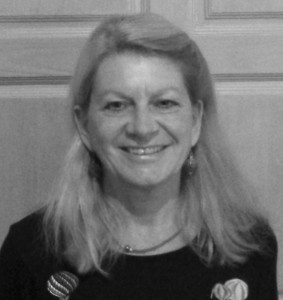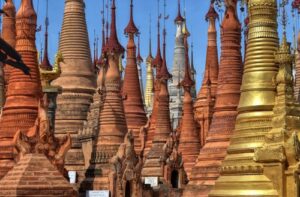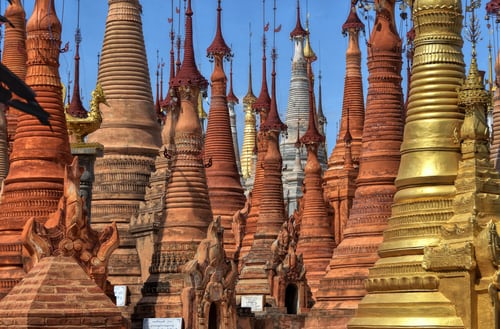11 February 2021
Myanmar Manoeuvres
The history, the heroine, the holocaust and Hlaig.
By Lynda Goetz
 It is now 10 days since the tanks rolled into Naypyidaw, capital of Myanmar. It was the day the new parliament was due to open, February 1st 2021. State Counsellor Aung San Suu Kyi was put under house arrest (again) and various members of her National League for Democracy (NLD) party arrested. Most have now been released. She is still being detained on the grounds, inter alia, that she had walkie-talkies in her possession. This is enough to put her in prison and to bar her from future political office. Social media was initially closed down. It has now been reinstated and Generation Z are actively using it. Live protests around the country have been held on a daily basis. The response by the Tatmadaw (Myanmar military) now in charge was initially mild. Over the last few days it has become more violent. Several people are in hospital and by Wednesday one woman was reported to be in intensive care with a bullet in the back of her head. She is not expected to survive.
It is now 10 days since the tanks rolled into Naypyidaw, capital of Myanmar. It was the day the new parliament was due to open, February 1st 2021. State Counsellor Aung San Suu Kyi was put under house arrest (again) and various members of her National League for Democracy (NLD) party arrested. Most have now been released. She is still being detained on the grounds, inter alia, that she had walkie-talkies in her possession. This is enough to put her in prison and to bar her from future political office. Social media was initially closed down. It has now been reinstated and Generation Z are actively using it. Live protests around the country have been held on a daily basis. The response by the Tatmadaw (Myanmar military) now in charge was initially mild. Over the last few days it has become more violent. Several people are in hospital and by Wednesday one woman was reported to be in intensive care with a bullet in the back of her head. She is not expected to survive.
Myanmar is complicated. Most people, it seems, are agreed on this point at least. As to why the latest events have happened, there appears to be less consensus. Much of the reason appears to lie in its history. Myanmar, known in English as Burma until 1990 when the generals decreed a change of name, has only existed as a modern independent state since the end of the Second World War, when, on 4th January 1948, The Burma Independence Act 1947 came into force. After 124 years they had thrown off the yoke of being ruled by Britain.
Aung San, the father of Aung San Suu Kyi and regarded as the father of modern Burma, had succeeded earlier in that year in concluding agreements with several of the ethnic minority groups in the area for a unified Burma. The Anti-Fascist People’s Freedom League (AFFPL), led by Aung San, which had evolved out of the various military and left-wing political organisations he had founded or co-founded as a young man, won the elections in the spring of 1947. However, on 19 July he and several members of his cabinet were assassinated by a rival political group. He never saw his country independent.
Internal conflict was inherent from the start of that independence and there were numerous insurgencies and uprisings in the early years, caused by both political and ethnic differences [i]. The country struggled on, accepting foreign aid initially, but eventually rejecting it because of continued American support for the ongoing presence of the Chinese Nationalist military in the country. On 2nd March 1962 a ‘bloodless’ military coup was staged by General Ne Win with sixteen other senior military officers. They declared a socialist state, to be run by their Union Revolutionary Council. A number of protests followed and initially the response from the new rulers was mild. In July things took a turn for the worse when over 100 student protesters staging a peaceful protest on the Rangoon University campus were killed. Peace talks with various opposition groups over the next 18 months came to nothing and in March 1964 all opposition groups were banned. (The Kachin Independence Organisation would fight the rulers for the following 33 years). From this point on Burma was increasingly isolated by its rulers from the rest of the world as Ne Win attempted to impose his vision of a one-party socialist state. Repression continued. In 1976, Operation Dragon King or Nagamin was conducted against the Rohingya Muslims causing 250,000 to flee to neighbouring Bangladesh. Some 180,000 returned a few years later, but the remainder and many of their descendants are still in Bangladesh.
By the 1980s the socialist stranglehold had resulted in a depleted economy which limited economic reforms in 1987-8 did little to change. The cancellation of certain bank notes in September 1987 by Ne Win led to a further economic downturn. Widespread protests and demonstrations during the spring and summer of 1988 culminated in the 8-8-88 uprising on 8th August. Rangoon students were once again at the centre of these, but the student protests spread around the country and throughout the population. The uprising came to an end on 18th September after a bloody military coup by the State Law and Order Restoration Council. The authorities put the number killed at a mere 350, but it is believed that thousands died.
It was during the 8888 Uprising that Aung San Suu Kyi came to prominence. Ostensibly back in Burma to visit her ailing mother (who had also been a political figure in her own right), Aung San Suu Kyi stepped up to grasp the political baton. Her unique position as the daughter of the ‘Father of the Nation’ made it easy for her to address a mass rally at the Shwedagon Pagoda on 25th August and then a month later to help found the National League for Democracy (NLD). By July the following year however she was under house arrest. Offered the chance to leave the country with her husband, English academic Dr Michael Aris whom she had married in 1972, she refused, fearful that she would never be allowed to return. In the ten years that followed she was to see her husband only five times. She was separated too from her sons, then aged 16 and 11, who were only granted entry visas from 2011. Her husband died in the UK at the age of 53 in 1999. She remained under house arrest for a total of 15 out of the next 21 years until November 2010. (Since 1st February this year she is once again confined).
Aung San Suu Kyi was for many years viewed as a heroine in the West as well as in her own country. Her personal sacrifices combined with her apparently serene acceptance of them made her an iconic figure. Her Buddhist beliefs were seemingly fundamental, although she said in 2007; “I do not hold to non-violence for moral reasons but for political and practical reasons”. Perhaps the political and practical have played more of a role in her decision-making over the years than observers wished to believe. In 1990 she was awarded the Sakharov Prize for Freedom of Thought and in 1991 the Nobel Peace Prize. After her release the NLD re-registered as a political party and she and a number of other members sought election as MPs. In 2012 she entered parliament. In spite of laws which had seemingly been put in place explicitly to stop her doing so, she had ambitions to run for the presidency in the 2015 elections. The NLD won a sweeping victory and was able to create the position of State Counsellor to get around the prohibition.
To the outside world Aung San Suu Kyi’s time as State Counsellor of Myanmar has hardly proved an unqualified success. Her lacklustre performance could be attributed to the constitutional constraints and the continued role of the generals in the government of the country. They hold 25% of parliamentary seats and have reserved to them several key cabinet posts. However, Aung San Suu Kyi’s imperious manner and inability to delegate have exacerbated problems. The 2017 re-emergence of the Rohingya issues, resulting in yet another mass exodus to Bangladesh as well as at least 10,000 dead, has not only seen her standing abroad plummet but the rescission of her Nobel Peace Prize.
In Myanmar things are viewed a little differently. Amongst the Bamar majority, Aung San Suu Kyi’s standing has not been diminished. Indeed her popularity with the ethnic group which forms the basis of her support has been enhanced. The Muslim Rohingya have never been popular in the mainly Buddhist country and tensions have been high since World War II. (The Brits may partly be to blame here as the Rohingya believed that in exchange for fighting the Japanese in the area Britain would reward them with a ‘Muslim National Area’. This never happened). Some Myanmar watchers believe that Aung San Suu Kyi’s performance at the International Court of Justice when she refused to denounce the generals ‘clearance operations’ positively burnished her credentials at home and led to the landslide NLD victories in the November 2020 elections.
Why though should this have concerned the generals, whose position in the constitution they set up seemed secure? Instead they have, like Donald Trump, loudly cried ‘fraud’. A fascinating briefing in The Economist suggests that it may have been the personal ambition of General Min Aung Hlaing which was at the root of the problem. As Commander-in-Chief of the Tatmadaw there is speculation that he had his own aspirations to become president. With the ‘stolen’ election and his retirement from his current post coming up in the summer, it could be that this was a last-ditch effort to secure his place in Myanmar’s history. An article on the Lowy Institute website by Professor Andrew Selth, author of a number of books on Myanmar (sent to me by my niece who worked for Médecins Sans Frontières in Myanmar helping with the displaced Rohingya), puts forward and then dismisses a number of current speculative theories about the timing and reasons behind the coup.
Could it have been a concern about loss of economic power by the Tatmadaw? He considers this less of a problem than the potential issue of sanctions by the US. The Economist on the other hand suggests that sanctions would, as usual, affect the poorest, not those in power able to work around them. The authors point out that President Biden’s Indo-Pacific tsar, Kurt Campbell, has a history of playing on Myanmar’s worries over China’s influence and preferring engagement rather than isolation.
Could the tensions between Aung San Suu Kyi and General Hlaing have reached breaking point? Little hard evidence for that either apparently. Was the coup at the behest of China? This seems highly unlikely for the reasons mentioned above. Both articles take the view that China will adjust its position to work with whoever exercises power.
‘Why’ asks Professor Selth, ‘would the Tatmadaw want to pick up the burden of the problems they had offloaded onto the NLD?’ Perhaps the NLD had proposals to change the constitution? The date of the latest coup may provide a clue. Apart from the convenience of having all the key players in the capital on that day, were they afraid of NLD plans? Given that according to the constitution more than 75% of the combined houses of parliament are needed to enforce a change and the Tatmadaw automatically has allocated 25% of seats in both houses, this would appear to be implausible. However, the NLD has found ways around the military’s carefully-crafted constitution before (e.g. the creation of the position of State Counsellor), so perhaps General Hlaig had got wind of Aung San Suu Kyi’s manoeuvres? She has never hidden her desire to make her country ‘more democratic’.

For now, the best theory would appear to be General Hlaig’s ambitions. Without him, there would have been no coup, so it is not unreasonable to think that he may well have his own personal reasons for acting when he did. Once again it is the young and the students who appear to be at the centre of the protest movement. They have personally not known the repression so inherent in their country’s political history. They do not consider it something they should have to accept. Social media gives them, like the Hong Kong protest movement, an advantage, but even if Myanmar is not China, that advantage may not be enough to bring down yet another repressive regime. From here, it seems, all we can do is watch. The Tatmadaw response may well echo what happened over two decades ago.
[i] There are many ethnic minorities in the country apart from the Rohingya. Many areas still have armed groups (eg the Kachin Independence Army, the Shan have a number of armed groups; the Rakhine have the Arakan Army; the Karen National Union has an armed wing etc).


